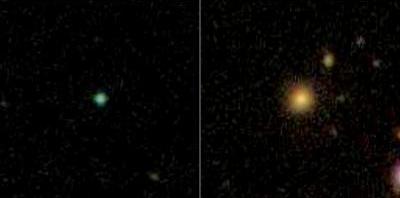
The galaxies were discovered with the help of citizen scientists working through an online project called Galaxy Zoo.
The Galaxy Zoo users, who volunteer their spare time to help classify galaxies in an online image bank, came across a number of objects that stuck out because of their small size and bright green color.
They dubbed them the "Green Peas".
Employing the help of the volunteers to further analyze these strange new objects, the astronomers discovered that the Green Peas are small, compact galaxies forming stars at an incredibly high rate.
"These are among the most extremely active star-forming galaxies we've ever found," said Carolin Cardamone, an astronomy graduate student at Yale and lead author of the paper.
Of the one million galaxies that make up Galaxy Zoo's image bank, the team found only 250 Green Peas.
"No one person could have done this on their own," Cardamone said. "Even if we had managed to look through 10,000 of these images, we would have only come across a few Green Peas and wouldn't have recognized them as a unique class of galaxies," she added.
The galaxies, which are between 1.5 billion and 5 billion light years away, are 10 times smaller than our own Milky Way galaxy and 100 times less massive.
But surprisingly, given their small size, they are forming stars 10 times faster than the Milky Way.
"They're growing at an incredible rate," said Kevin Schawinski, a postdoctoral associate at Yale and one of Galaxy Zoo's founders.
"These galaxies would have been normal in the early universe, but we just don't see such active galaxies today. Understanding the Green Peas may tell us something about how stars were formed in the early universe and how galaxies evolve," he added.



Reader Comments
to our Newsletter